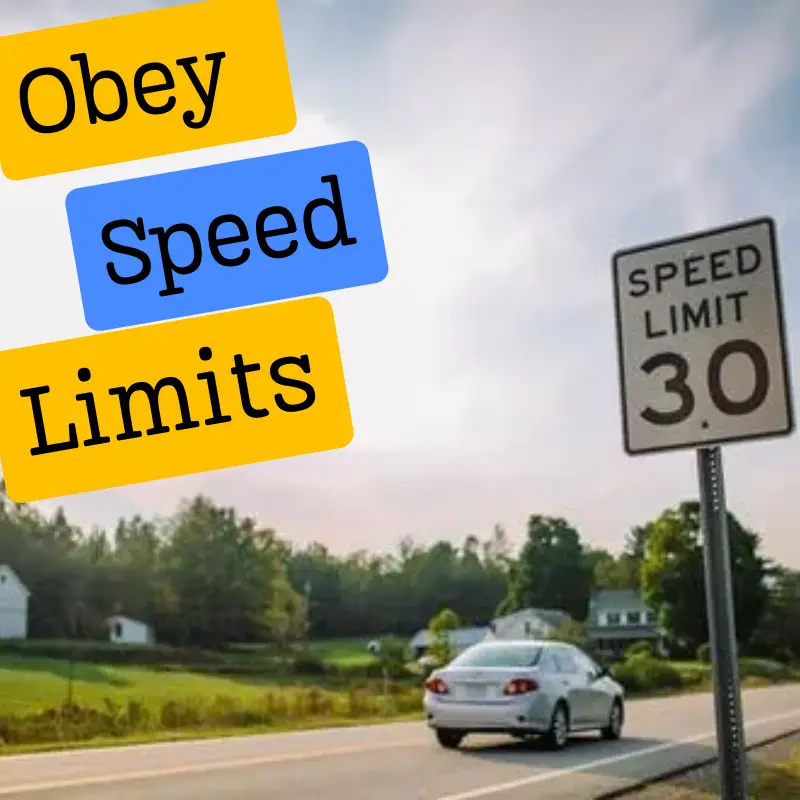Speed limits are established to ensure the safety of drivers, passengers, pedestrians, and cyclists. While it might be tempting to push the accelerator a little harder, understanding and adhering to speed limits is crucial for maintaining order on the roads and preventing accidents. In this comprehensive exploration, we will delve into the reasons why obeying these limits is essential, the potential consequences of speeding, and the broader impact on road safety.
I. The Purpose of Speed Limits
A. Setting a Safe Standard
The primary objective of these limits is to establish a safe and consistent standard for vehicular movement. Road authorities carefully determine these limits based on various factors, including road design, traffic flow, and the surrounding environment. By obeying these limits, drivers contribute to an organized and predictable traffic system, reducing the likelihood of accidents and promoting a smoother flow of vehicles.
B. Protecting Vulnerable Road Users
Pedestrians, cyclists, and other vulnerable road users greatly benefit from adhering to speed limits. Slower speeds give drivers more time to react to unexpected situations, such as a pedestrian crossing the road or a cyclist navigating through traffic. The adherence to speed limits creates a safer environment for all road users, fostering a sense of shared responsibility among the community.

II. Consequences of Speeding
A. Increased Risk of Accidents
Excessive speed significantly raises the risk of accidents. When a vehicle is traveling at a high speed, the driver has less time to react to sudden changes in the road environment, such as a curve, an obstacle, or another vehicle making an unexpected maneuver. By obeying speed limits, drivers provide themselves with the necessary time and space to respond to unforeseen circumstances, ultimately reducing the probability of collisions.
B. Severity of Collisions
Not only does speeding increase the likelihood of accidents, but it also amplifies the severity of the impact. The force generated in high-speed collisions can lead to more severe injuries and fatalities. Obeying speed limits serves as a critical factor in minimizing the potential damage and harm caused by accidents, protecting both drivers and passengers.
III. Impact on Road Safety
A. Traffic Flow and Congestion
Adhering to speed limits is not just about preventing accidents; it also contributes to maintaining a smooth traffic flow. Consistent and moderate speeds help prevent unnecessary congestion, especially in high-traffic areas or during peak hours. When drivers respect speed limits, they create a harmonious driving environment that benefits everyone on the road.
B. Emergency Response
Obeying speed limits is paramount for emergency response vehicles. In cases of accidents, fires, or medical emergencies, timely arrival can make a crucial difference. Maintaining appropriate speeds allows emergency vehicles to navigate through traffic efficiently and reach their destinations without unnecessary delays.
IV. Legal Consequences of Speeding
A. Fines and Penalties
One of the immediate consequences of disregarding speed limits is the imposition of fines and penalties. Law enforcement agencies employ various methods, including speed cameras and patrols, to monitor and enforce speed limits. Fines serve as a deterrent, encouraging drivers to comply with speed regulations and promoting a safer driving culture.
B. License Points and Suspensions
Recurring instances of speeding can lead to the accumulation of demerit points on a driver’s license. In many jurisdictions, reaching a certain threshold of points can result in license suspension. This serves as a more severe consequence for habitual speeders, emphasizing the gravity of the offense and the importance of responsible driving.
V. Technology and Speed Limit Enforcement
A. Speed Limiting Technology
Advancements in technology have introduced innovative solutions for enforcing speed limits. Some modern vehicles come equipped with speed-limiting technology that restricts the vehicle’s speed to the posted limit. While controversial, these systems aim to provide an additional layer of safety by preventing drivers from exceeding established speed thresholds.
B. Automated Speed Cameras
Automated speed cameras have become a prevalent method for enforcing speed limits. These cameras capture images or videos of vehicles exceeding the speed limit, leading to the issuance of fines. While criticized by some as revenue-generating tools, automated speed cameras serve as an effective means of encouraging compliance with speed regulations.
VI. Public Awareness and Education
A. Campaigns and Initiatives
Public awareness and education campaigns play a crucial role in promoting the importance of obeying speed limits. Governments, non-profit organizations, and community groups often collaborate to launch initiatives that highlight the dangers of speeding and emphasize the benefits of responsible driving. These campaigns aim to shape public attitudes and encourage a collective commitment to road safety.
B. Driver Education Programs
Driver education programs are instrumental in instilling safe driving practices, including the significance of adhering to speed limits. Incorporating information about the consequences of speeding and the broader impact on road safety into driver training courses can contribute to creating a culture of responsible driving from the outset.
VII. International Perspectives on Speed Limits
A. Variability in Speed Limits
Speed limits vary widely across countries and regions, reflecting differences in infrastructure, traffic patterns, and cultural attitudes toward road safety. While some nations enforce stringent speed limits, others allow higher speeds on certain road types. Examining international perspectives provides valuable insights into the effectiveness of different approaches to speed regulation.
B. Harmonizing Speed Limits
Efforts to harmonize speed limits internationally have gained traction, driven by the desire to create a standardized approach to road safety. Harmonization involves aligning speed limits across borders to create a consistent experience for drivers and promote a shared understanding of safe driving speeds. However, challenges such as cultural differences and varying road conditions present hurdles to achieving complete uniformity.
VIII. Future Trends and Technologies
A. Intelligent Speed Adaptation
Intelligent Speed Adaptation (ISA) is an emerging technology designed to enhance speed limit compliance. ISA systems use GPS and mapping data to determine the appropriate speed for a given road and automatically adjust a vehicle’s speed to match that limit. While still in the early stages of adoption, ISA holds promise for improving overall road safety.
B. Connected Vehicles and Infrastructure
The rise of connected vehicle technology presents opportunities for improving speed limit adherence. Vehicles equipped with communication systems can receive real-time data about road conditions, traffic, and speed limits from infrastructure. This information can be used to alert drivers and automatically adjust vehicle speeds, fostering a safer and more responsive driving environment.

Conclusion
In conclusion, obeying speed limits is a fundamental aspect of responsible and safe driving. Speed limits are not arbitrary restrictions but carefully calculated measures aimed at protecting road users and maintaining a harmonious traffic flow. The consequences of speeding are severe, ranging from an increased risk of accidents and their severity to legal repercussions and the potential suspension of driving privileges.
Technology, public awareness campaigns, and international initiatives all play pivotal roles in promoting adherence to speed limits. As we look to the future, advancements in intelligent speed adaptation and connected vehicle technology hold promise for further enhancing road safety. Ultimately, the commitment to obeying speed limits is a shared responsibility that requires the cooperation of drivers, law enforcement agencies, and policymakers to create a safer and more sustainable road environment for everyone.
